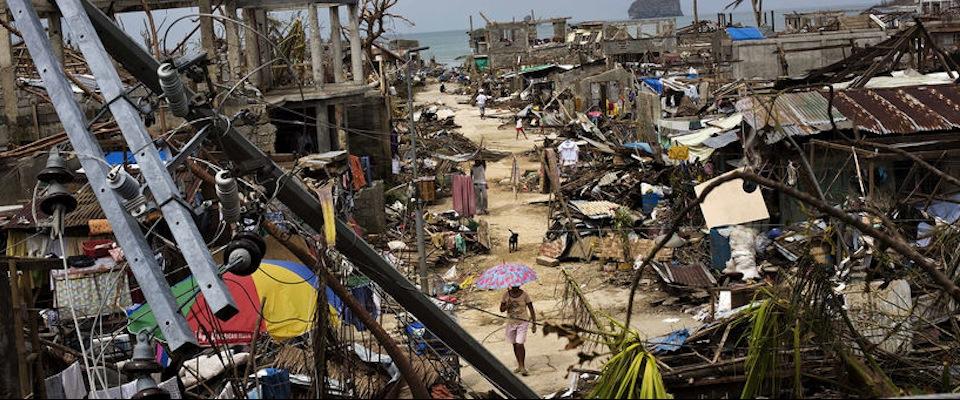Typhoon Haiyan was not an anomaly. Researchers confirm that we should expect more such tropical “super storms” as the planet warms inexorably from human activity. And the grim fact is that a good percentage of these massive cyclones will slam into the Philippines.
“The Philippines is situated in a unique—and unfortunate—spot on the planet,” says Solomon Hsiang, an assistant professor at UC Berkeley’s Goldman School of Public Policy.
Hsiang specializes in calculating the impacts of climate change and natural disasters on societies and economies. He made headlines a couple of months ago as lead author of a paper published in the journal Science. The paper showed links between climate change and increased human conflict. And he was deep into a project on the impacts of typhoons on the Philippines when Typhoon Haiyan hit last week.
“The Pacific Ocean is the most active region in the world for hurricanes,” Hsiang explains. “These storms invariably travel north and west, and that puts the Philippines right in their path. Typhoons are just a fact of life there. ” Hurricanes (or typhoons, as cyclones are termed in Asia) have been particularly difficult to address in computer models, but that’s changing rapidly, according to Michael Wehner, a staff scientist at Lawrence Berkeley National Laboratory who studies extreme weather events and climate change.
“We’ve had good success in modeling heat waves (predicated on climate change),” Wehner says. “The Paris heat wave of 2003 and the Russian heat wave of 2010 both largely conformed to our models. Typhoons have been more difficult, but we’ve made tremendous advances in the last few years. We’re really honing in on them now.”
Wehner said current research indicates there actually may be fewer tropical typhoons as the planet heats up, because a warmer atmosphere combined with a warmer ocean means a more stable climatic system. There will be lower “wind shear”—in other words, the difference in winds in the lower and upper atmospheres will be less.
But there is a major catch: all that heat also translates into greater energy. Hurricanes are basically mechanisms that remove heat from the ocean, transferring it to the atmosphere. So the storms that do develop in our hothouse future will likely be more powerful and destructive.
“What’s likely to happen is that the storms that were on the verge of Category 4 or 5 in the past will develop into full Category 4 or 5 storms as climate change progresses,” warns Wehner.
It’s perhaps small comfort, but such storms may be constrained in a certain sense by their very power. “Haiyan was an interesting storm, in that it was quite compact,” says Wehner. “Katrina, a much less powerful storm, had hurricane force winds 100 kilometers from the eye wall. Haiyan’s hurricane force winds extended only about 50 kilometers. It’s sort of like when a figure skater pulls her arms in, and she spins faster—the velocity of the winds made the (physical dimensions) of the storm smaller.”
Wehner emphasizes that no single event can be attributed to climate change. “That would be an oversimplification,” he says, but he adds that it is possible to calculate the risk of such events as a climate system changes. “And from that perspective, Haiyan is a good candidate. My view, though speculative, is that this storm indicates the risk (of increased incidence of large cyclones) has increased due to climate change.”
And as noted, any increase in cyclone strength in the Pacific is bound to bode ill for the Republic of the Philippines. The destruction to human life and property from a single storm of Haiyan’s magnitude is horrific. But Hsiang says that perhaps even more disturbing are the long-term impacts of cyclones—any cyclone—to Philippine society.
“We’ve found that the impacts for the year following a typhoon landfall are typically fifteen times larger than the initial cost of the landfall in both human mortality and economic activity,” Hsiang says. “These are really diffuse, long-term impacts, and they occur on a very large scale. We found, for example, a big spike in infant mortality—particularly for female infants—in affected areas one year after a typhoon landfall. Infants not even conceived before the storm end up at far greater risk of dying if they’re born in a typhoon-affected area.”
Why? The mean household income for the Philippines is relatively low. After a typhoon hits, most people must shift a significant portion of their economic assets away from such basics as food, education and health care to home reconstruction. This also often means they must take time away from their work to rebuild their houses, so less money is coming in, further eroding an already marginal standard of living.
“Out of necessity, they don’t eat as well and they neglect medical care,” Hsiang says. “Education of children also is cut back, so options for upward mobility are increasingly limited. And these impacts don’t go away after a year. We’re finding effects are lingering five years later.”
Further, the effects are often cumulative, in that communities may be hit multiple times over a period of years.
“The Philippines get on average 14 big tropical storms a year,” says Hsiang. “So the pressure on the society as a whole is constant. We’ve determined that the average Filipino household loses 7 percent in income in an average year due to typhoons. That’s an extra ‘income tax’ extracted from families that has no benefit—it’s money that could otherwise have been invested in better food, better health care or small businesses.”
There is some indication that repeated exposure to typhoons inculcates a certain degree of resiliency.
“We found that those areas of the Philippines that get hit most frequently tend to be better adapted,” Hsiang says. “There’s less loss of income and better general health. We don’t know why that is—maybe people have learned to reinforce their homes better, so there’s less damage. Or conversely, maybe they invest less money in their homes so even if they are damaged, they can be repaired quickly and cheaply.”
It might seem that climate change-induced sea level rise could be contributing to the destruction in low-lying areas of the Philippines and other Pacific Island nations. But Hsiang doesn’t think that’s the case—not yet, anyway.
“Storm surge (from typhoons) is the real issue,” he insists. “To date, sea level rise is being measured in centimeters, but storm surges from these huge storms are measured in meters or tens of meters. The storm surge would still be deadly, with or without the sea level rise we’ve seen to date. A hundred years from now it could be a significant contributing factor to mortality and property destruction. But not now.”
The Philippines’ typhoon dilemma has many of the markings of a classic “wicked problem”—in social planning, a conundrum that seems to have no possible solution. But researchers believe that’s insufficient reason for giving up, considering that the lives of almost 100 million people are at stake.
“For me, our research emphasizes that we can’t view these storms as isolated events,” says Hsiang. “Our responses have to take long-term response into account. We need policies with staying power.”
The UC Berkeley News Center has more information here on plans to honor the typhoon’s survivors and raise money for its victims here.



















